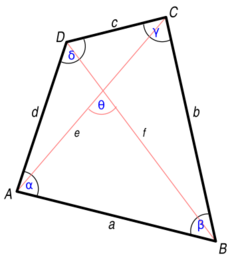Bretschneider's formula
In geometry, Bretschneider's formula is a mathematical expression for the area of a general quadrilateral. It works on both convex and concave quadrilaterals (but not crossed ones), whether it is cyclic or not.
History
The German mathematician Carl Anton Bretschneider discovered the formula in 1842. The formula was also derived in the same year by the German mathematician Karl Georg Christian von Staudt.
Formulation
Bretschneider's formula is expressed as:
- [math]\displaystyle{ K = \sqrt {(s-a)(s-b)(s-c)(s-d) - abcd \cdot \cos^2 \left(\frac{\alpha + \gamma}{2}\right)} }[/math]
- [math]\displaystyle{ = \sqrt{(s-a)(s-b)(s-c)(s-d) - \tfrac{1}{2} abcd [ 1 + \cos (\alpha+ \gamma) ]} . }[/math]
Here, a, b, c, d are the sides of the quadrilateral, s is the semiperimeter, and α and γ are any two opposite angles, since [math]\displaystyle{ \cos (\alpha+ \gamma) = \cos (\beta+ \delta) }[/math] as long as [math]\displaystyle{ \alpha+\beta+\gamma+\delta=360^{\circ}. }[/math]
Proof
Denote the area of the quadrilateral by K. Then we have
- [math]\displaystyle{ \begin{align} K &= \frac{a d \sin \alpha}{2} + \frac{b c \sin \gamma}{2}.\end{align} }[/math]
Therefore
- [math]\displaystyle{ 2K= (ad) \sin \alpha + (bc) \sin \gamma. }[/math]
- [math]\displaystyle{ 4K^2 = (ad)^2 \sin^2 \alpha + (bc)^2 \sin^2 \gamma + 2abcd \sin \alpha \sin \gamma. }[/math]
The law of cosines implies that
- [math]\displaystyle{ a^2 + d^2 -2ad \cos \alpha = b^2 + c^2 -2bc \cos \gamma, }[/math]
because both sides equal the square of the length of the diagonal BD. This can be rewritten as
- [math]\displaystyle{ \frac{(a^2 + d^2 - b^2 - c^2)^2}{4} = (ad)^2 \cos^2 \alpha +(bc)^2 \cos^2 \gamma -2 abcd \cos \alpha \cos \gamma. }[/math]
Adding this to the above formula for 4K2 yields
- [math]\displaystyle{ \begin{align} 4K^2 + \frac{(a^2 + d^2 - b^2 - c^2)^2}{4} &= (ad)^2 + (bc)^2 - 2abcd \cos (\alpha + \gamma) \\ &= (ad+bc)^2-2abcd-2abcd\cos(\alpha+\gamma) \\ &= (ad+bc)^2 - 2abcd(\cos(\alpha+\gamma)+1) \\ &= (ad+bc)^2 - 4abcd\left(\frac{\cos(\alpha+\gamma)+1}{2}\right) \\ &= (ad + bc)^2 - 4abcd \cos^2 \left(\frac{\alpha + \gamma}{2}\right). \end{align} }[/math]
Note that: [math]\displaystyle{ \cos^2\frac{\alpha+\gamma}{2} = \frac{1+\cos(\alpha+\gamma)}{2} }[/math] (a trigonometric identity true for all [math]\displaystyle{ \frac{\alpha+\gamma}{2} }[/math])
Following the same steps as in Brahmagupta's formula, this can be written as
- [math]\displaystyle{ 16K^2 = (a+b+c-d)(a+b-c+d)(a-b+c+d)(-a+b+c+d) - 16abcd \cos^2 \left(\frac{\alpha + \gamma}{2}\right). }[/math]
Introducing the semiperimeter
- [math]\displaystyle{ s = \frac{a+b+c+d}{2}, }[/math]
the above becomes
- [math]\displaystyle{ 16K^2 = 16(s-d)(s-c)(s-b)(s-a) - 16abcd \cos^2 \left(\frac{\alpha + \gamma}{2}\right) }[/math]
- [math]\displaystyle{ K^2 = (s-a)(s-b)(s-c)(s-d) - abcd \cos^2 \left(\frac{\alpha + \gamma}{2}\right) }[/math]
and Bretschneider's formula follows after taking the square root of both sides:
- [math]\displaystyle{ K = \sqrt {(s-a)(s-b)(s-c)(s-d) - abcd \cdot \cos^2 \left(\frac{\alpha + \gamma}{2}\right)} }[/math]
The second form is given by using the cosine half-angle identity
- [math]\displaystyle{ \cos^2 \left(\frac{\alpha + \gamma}{2}\right) = \frac {1 + \cos \left(\alpha + \gamma\right)}{2}, }[/math]
yielding
- [math]\displaystyle{ K = \sqrt{(s-a)(s-b)(s-c)(s-d) - \tfrac{1}{2} abcd [ 1 + \cos (\alpha+ \gamma) ]} . }[/math]
Emmanuel García has used the generalized half angle formulas to give an alternative proof. [1]
Related formulae
Bretschneider's formula generalizes Brahmagupta's formula for the area of a cyclic quadrilateral, which in turn generalizes Heron's formula for the area of a triangle.
The trigonometric adjustment in Bretschneider's formula for non-cyclicality of the quadrilateral can be rewritten non-trigonometrically in terms of the sides and the diagonals e and f to give[2][3]
- [math]\displaystyle{ \begin{align} K &=\tfrac{1}{4}\sqrt{4e^2f^2-(b^2+d^2-a^2-c^2)^2} \\ &=\sqrt{(s-a)(s-b)(s-c)(s-d) - \tfrac{1}{4}((ac+bd)^2-e^2f^2)}. \end{align} }[/math]
Notes
- ↑ E. A. José García, Two Identities and their Consequences, MATINF, 6 (2020) 5-11. [1]
- ↑ Coolidge, J. L. (1939). "A Historically Interesting Formula for the Area of a Quadrilateral". The American Mathematical Monthly 46 (6): 345–347. doi:10.2307/2302891.
- ↑ Hobson, E. W. (1918). A Treatise on Plane Trigonometry. Cambridge University Press. pp. 204–205. https://archive.org/details/treatiseonplanet00hobs/page/n7/mode/2up.
References & further reading
- Ayoub, Ayoub B. (2007). "Generalizations of Ptolemy and Brahmagupta Theorems". Mathematics and Computer Education 41 (1). ISSN 0730-8639.
- C. A. Bretschneider. Untersuchung der trigonometrischen Relationen des geradlinigen Viereckes. Archiv der Mathematik und Physik, Band 2, 1842, S. 225-261 (online copy, German)
- F. Strehlke: Zwei neue Sätze vom ebenen und sphärischen Viereck und Umkehrung des Ptolemaischen Lehrsatzes. Archiv der Mathematik und Physik, Band 2, 1842, S. 323-326 (online copy, German)
External links
- Weisstein, Eric W.. "Bretschneider's formula". http://mathworld.wolfram.com/BretschneidersFormula.html.
- Bretschneider's formula at proofwiki.org
 |


